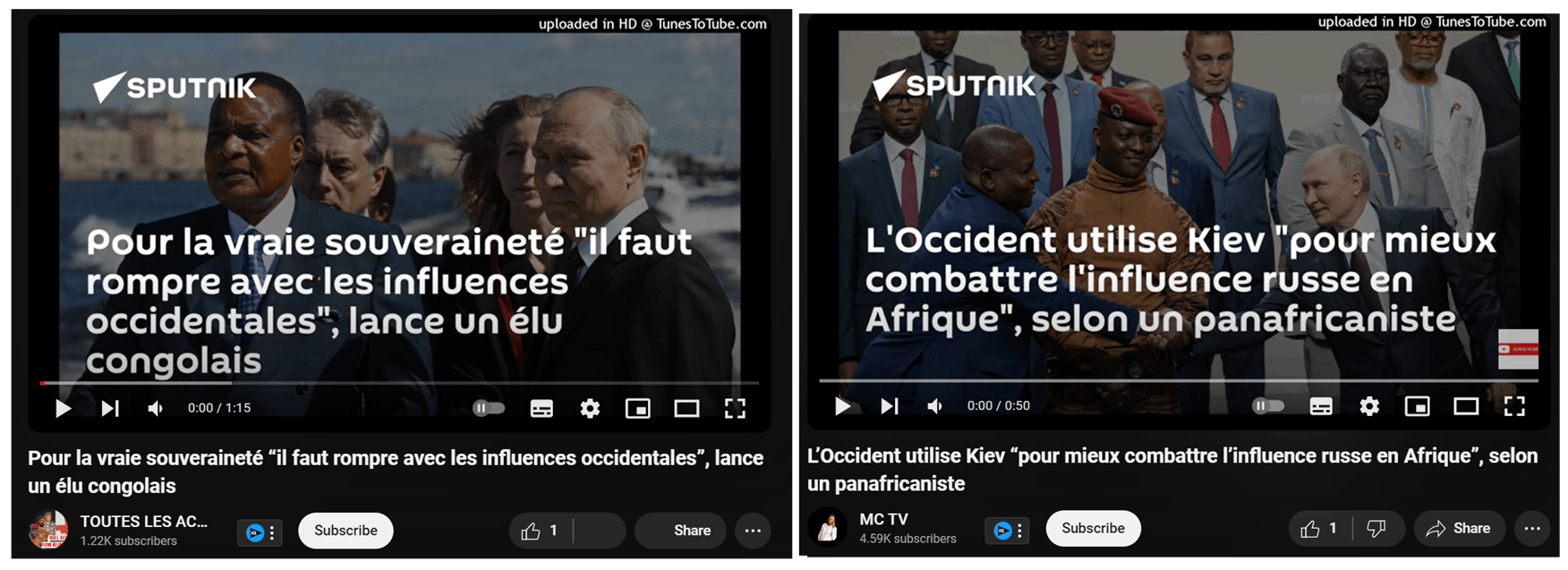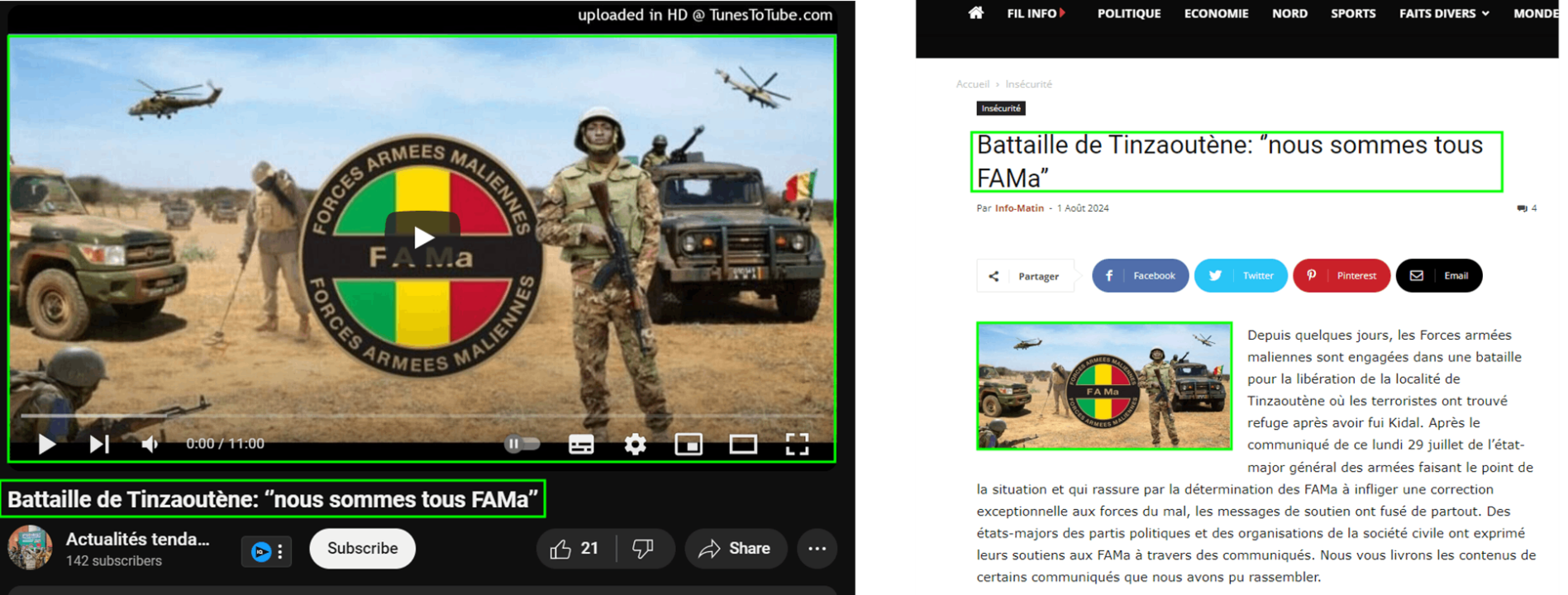Pro-Russia, pro-Wagner activity surges following Mali and Wagner forces’ defeat in battle
An inauthentic network of YouTube channels pushed pro-AES and anti-Ukraine narratives after the Tinzaouaten confrontation

BANNER: People gather in front of a makeshift memorial, which was erected following head of Russia’s Wagner Group Yevgeny Prigozhin’s death in 2023, during an August 4, 2024, commemoration ceremony held to pay tribute to Wagner fighters killed in Mali. (Source: Reuters/Yulia Morozova)
A network of twenty-seven YouTube channels, targeting at least eight West African countries, is spreading pro-Russia and pro-Wagner Group content, with a notable surge in activity following the defeat of Malian and Wagner forces in the battle of Tinzaouaten in northern Mali. The channels appear to be utilizing AI-generated narration to repost content stolen from both trusted local news sources and the Russian media outlet Sputnik. The channels most often shared content focused on Sahelian politics and the domestic political landscape of West African countries, with a significant focus on Mali and Niger.
In late July, a confrontation occurred near the village of Tinzaouaten, located in northern Mali’s Kidal region near the border with Algeria, between Malian armed forces (abbreviated as FAMa in French), backed by the Wagner Group, and the forces of the Strategic Framework for the Defense of the People of Azawad (CSP-DPA). Between July 25 and July 28, the CSP-DPA forces launched an ambush against FAMa and Wagner, resulting in up to eighty-seven Wagner and forty-seven FAMa fatalities, according to unverified claims by the CSP-DPA, and the reported death of Russian propagandist and author of the Telegram channel “Grey Zone” Nikita Fedyanin. After the attack, Mali and Burkina Faso launched a series of joint retaliatory drone strikes “in solidarity with member states [of the AES],” which reportedly killed six civilians.
Shortly after the battle, diplomatic tensions between Mali and Ukraine intensified. Online, a claim spread that Ukraine may have aided the CSP-DPA forces. A July 26 televised allocution by Ukrainian General Intelligence Directorate Spokesperson Andryi Yusov was interpreted by the Malian government as an acknowledgement of Ukraine’s indirect support for the CSP-DPA forces, resulting in Mali cutting diplomatic ties with Ukraine, followed shortly after by Niger. The DFRLab observed that the battle and the diplomatic repercussions between Mali, Niger, and Ukraine were the primary focus of the narratives amplified by the network.
YouTube network
The names of the identified YouTube channels often included the words “News,” “Trends,” or “Updates” and the name of a West African country, typically Mali, Niger, Togo, Burkina-Faso, Côte d’Ivoire, or Guinea. The channels consistently stole content from trusted news sources, such as Maliweb, Malijet, Senenews, and RFI. The channels often narrate the content of the article, seemingly using AI. At the time of writing, the network had posted 48,869 videos, received 165,224 subscribers, and amassed more than 31 million views. The oldest channel in the network, “Mises à jour sur le Togo” (Updates on Togo), was created in 2015 and had posted 11,971 videos; it received nearly half of the total views, with more than 16 million total views at the time of writing.
In addition, three of the channels had similar descriptions, an indication of possible coordination. The channels “Maliba News,” “Infos Guinee,” and “Infos Faso” all have nearly identical descriptions despite being created years apart.

Despite the channel name indicating a specific country focus for the content, the channels posted a range of content, often similar to each other, and in some cases, identical videos with identical titles were posted across the network.
Throughout the course of our investigation, the channel “FAURE GNASSINGBE YOUTUBE CHANNEL 🇹🇬,” which names Togo’s president in its title, changed its name to “Mali Actualite’s” (Mali News). The channel’s YouTube handle remains @FAURE-n7m. This indicates that the channels can seemingly pivot their focus from one country to the other.
The channels post video content to YouTube using TunesToTube, a third-party service that allows for coordinated posting of YouTube videos using soundtracks and images. The channels MC TV and “TOUTES LES ACTUALITÉS AFRICAINES” (ALL AFRICAN NEWS) seem to have only recently begun posting videos using TunesToTube, despite being created earlier.
Although some of the network’s activity has decreased since 2017, eight new channels were created in 2024. By downloading the metadata of the 7,836 videos posted by this subset of new channels, and querying keywords in the video titles, the DFRLab established what countries and topics appeared most often. At the time of writing, the latest videos posted by the channels most often dealt with Niger, the Sahel, Mali, France, Togo, Guinea, and Russia.
Furthermore, the network posted fourteen videos about the AES that were taken from Sputnik. In multiple instances, the YouTube video thumbnails were identical to the thumbnails used by Sputnik in its articles. The DFRLab collected all the articles posted by Sputnik Afrique that contain the tag “Alliance des États du Sahel (AES) in French and found that the network reused 15 percent of Sputnik’s articles. The channels that reposted Sputnik content purport to focus on Mali and Burkina Faso (Mali Meilleurs Nouvelles [Mali Best News], Notre pays Mali [Our Country Mali], Mali actualite’s [Mali news], Maliba News, and Faso infos [Faso information]). However, the most recent examples of Sputnik material posted by the network were found on TOUTES LES ACTUALITES AFRICAINES and MC TV, which do not appear to focus on Mali or Burkina Faso.

Promotion of the AES and coverage of the security situation in Tinzaouaten
Overall, the Sahel region was referenced in 273 videos. While the AES was among the least posted about topics, the most frequently reshared videos across the channels were those that focused on the AES.
At the time of writing, the most reshared videos of those posted in 2024 were titled “Présidence de la confédération AES: Les grands chantiers d’Assimi” (“Presidency of the confederation of the AES: Assimi’s major projects”), which was posted eight times within the network, and “AES-CEDEAO: Interrogations sur un divorce imposé,” (“AES-ECOWAS: Questions about an imposed divorce”), which was posted four times. In some instances, the videos also appeared on channels created before 2024. For the video thumbnails, the channels stole images from the news articles they were copying.

In addition, the network posted nineteen videos about the situation in Tinzaouaten. Five videos were resposted twelve times across the channels, and all stole their titles from trusted news sources such as Maliweb, Aïr Info, and the official press agency of Burkina-Faso.
The videos often amplified the response of the FAMa and promoted the purported success of the joint Malian and Burkinabe task force in retaliating against the Azawad forces.
Before the Tinzaouaten confrontation, the channels had only mentioned Ukraine two times in 2024. However, beginning on July 30, twenty-one videos concerning Ukraine appeared on the network; most of them reported on Mali and Niger cutting diplomatic ties with Ukraine. Several videos referred to Ukraine as a “terrorist,” furthered a claim that suggested Ukraine would have “attacked” Mali, and called for sanctions against Kyiv.

Cite this case study:
Valentin Châtelet, “Pro-Russia, pro-Wagner activity surges following Mali and Wagner forces’ defeat in northern battle,” Digital Forensic Research Lab (DFRLab), August 24, 2024, https://dfrlab.org/2024/08/30/pro-russia-pro-wagner-activity-surges-following-mali-and-wagner-forces-defeat-in-battle/.

